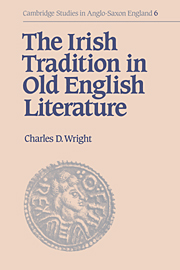Book contents
- Frontmatter
- Contents
- Acknowledgements
- List of abbreviations
- 1 Introduction
- 2 The ‘enumerative style’ in Ireland and Anglo-Saxon England
- 3 The Visio S. Pauli and the Insular vision of hell
- 4 Apocryphal cosmology and Celtic myth in ‘The Devil's Account of the Next World’
- 5 The literary milieu of Vercelli IX and the Irish tradition in Old English literature
- Appendix: Vercelli Homily IX and ‘The Devil's Account of the Next World’
- Bibliography
- Index
2 - The ‘enumerative style’ in Ireland and Anglo-Saxon England
Published online by Cambridge University Press: 18 March 2010
- Frontmatter
- Contents
- Acknowledgements
- List of abbreviations
- 1 Introduction
- 2 The ‘enumerative style’ in Ireland and Anglo-Saxon England
- 3 The Visio S. Pauli and the Insular vision of hell
- 4 Apocryphal cosmology and Celtic myth in ‘The Devil's Account of the Next World’
- 5 The literary milieu of Vercelli IX and the Irish tradition in Old English literature
- Appendix: Vercelli Homily IX and ‘The Devil's Account of the Next World’
- Bibliography
- Index
Summary
The structure of Vercelli IX, according to Paul Szarmach, is common to a number of the homilies in the Vercelli Book: a ‘formula of introduction, an appropriate number of preparatory motifs, a central narrative episode or exposition, and a closing’. In Vercelli IX the preparatory motif section is given structural weight equal to the central narrative episode, ‘The Devil's Account of the Next World’. The homily, then, consists of these two major parts, framed by an introduction and a conclusion. The preparatory motif section consists of a series of enumerations ‘be deaðes onlicnesse be helle gryre', arranged in ascending order: three deaths and lives, four separations and five likenesses of hell. Although the homilist's immediate source has not been recovered, parallels in Hiberno-Latin and Irish compilations suggest that he has culled these numerical themes from a florilegium of Irish origin or inspiration. In the following pages I shall describe several Hiberno-Latin florilegia, dialogues and homily collections that transmit a common stock of numerical motifs, some of which found their way from Irish compilations into Old English homilies.
THE IRISH ‘ENUMERATIVE STYLE’
The numerical apophthegm is, of course, a widespread and ancient literary form. As a recurrent stylistic feature of biblical (especially Old Testament) and apocryphal literature, it naturally was cultivated by patristic and medieval authors. Indeed, Jean Leclercq regards the use of enumerations as a method of composition characteristic of monastic authors. Leclercq, however, was chiefly concerned with texts dating from the twelfth century and later, when the practice of enumerating the points of a sermon and structuring didactic treatises upon numerical themes was given impetus by the logical and rhetorical methods of scholasticism.
- Type
- Chapter
- Information
- The Irish Tradition in Old English Literature , pp. 49 - 105Publisher: Cambridge University PressPrint publication year: 1993



